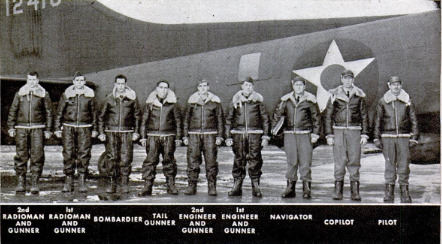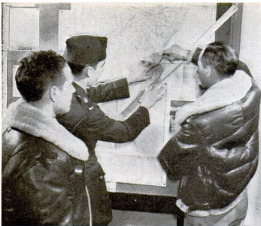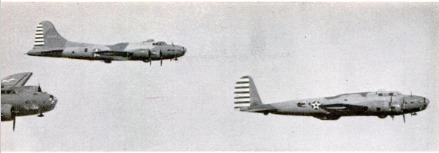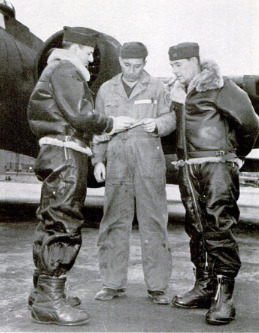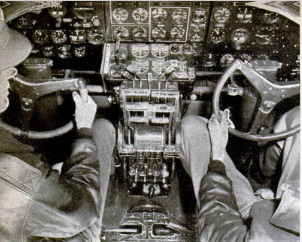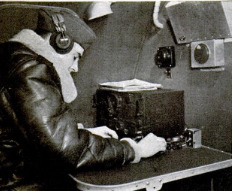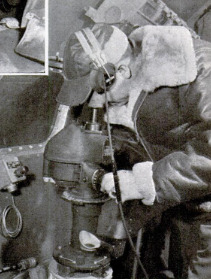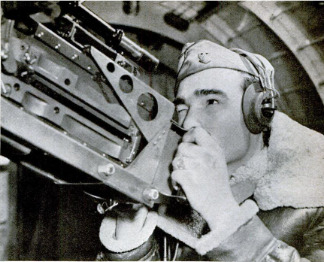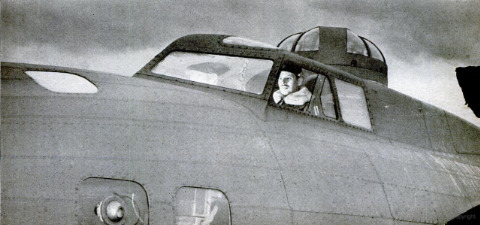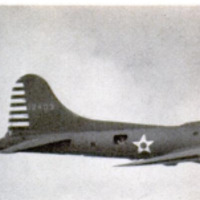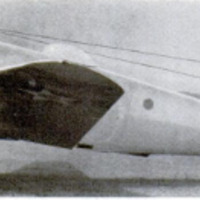-
Title (Dublin Core)
-
Precision bombing tanks teamwork
-
Article Title and/or Image Caption (Dublin Core)
-
Title:
Precision bombing tanks teamwork
-
extracted text (Extract Text)
-
WHEN you hear the men on the far bat-
Wee fronts calling for planes and more
planes, just remember that what they really
are asking for is combat teams and more
teams—equipped with fighting airplanes, of
course.
The efficient operation of a bombardment
airplane involves one of the most intimate
mergers of personality ever attempted or
achieved by seven, eight, or nine aggressive,
hard-hitting, individualistic American
youngsters. This suppression of ego and
merger of fighting men into a single combat
organism is so basic and well understood by
military flyers that they hardly even men-
tion it when they call for “planes.” But its
necessity should be understood by us lay-
men, too, lest we jump too easily to the con-
clusion that bombers are ready for aggres-
sive action as soon as they roll off the as-
sembly lines.
This sobering thought is the product of
several days spent talking with bombard-
ment men up and down the Atlantic coast.
These men are the nucleus of America’s hit-
ting power, and they are eager to get at the
enemy and smite him. But throughout these
talks ran one theme—the urgency, the nec-
essity of developing a combat team for
every plane.
The kind of men who fight with airplanes
do not talk easily about their intimate per-
sonal relationships. It was difficult to get at
the simple details of what their teamwork
implies, and the details they did point out
were generally negative. As in marriage,
the happy combination goes along smoothly
and uneventfully; it is the unsuccessful re-
lationship which causes talk.
“It's this way,” said one Flying Fortress
pilot. “If I don't like the color of my bom-
bardier’s eyes, or he doesn’t like the cut of
my jib, we just aren’t going to get very good
results, that's all.”
And then, completely unaware, this pilot
proceeded to give me a dramatic demonstra-
tion of the subject.
He had just brought his plane back from
a patrol mission hundreds of miles over the
Atlantic, hunting for submarines and sus-
picious vessels. It was a six-hour mission
and they had returned an hour and a half
late. There was a pea-soup fog that morn-
ing, and it had been a tense and difficult day.
The pilot had landed his four-engine ship,
carrying full bomb load, and with a low
ceiling.
I gathered that the difficulty had been
with navigation. On the best day, naviga- |
tion is difficult on this kind of mission, for
you are frequently circling ships and other-
wise changing course to complicate the cal-
culations. It had been especially tough in |
this day’s fog. |
“We'll be all right,” said the pilot, “when
our navigator gets a bit more experience.”
There it was. I knew, but the pilot did not |
yet know, that the navigator was quite as
experienced as this pilot, if not more so. For
six months he had been navigator for one of
the best bombardment pilots in the Ameri-
can Army. He was accus-
tomed, of course, to the ways
of the pilot with whom he
had been training.
Here were two good men
who, in the process of ex-
panding the Air Forces and
reorganizing a squadron, had
been put together for the
first time. In a few days, or a few weeks,
they would learn each other’s peculiarities,
learn to work together as a team. In the
meantime, if you tried to send them out on
a difficult bombing mission, it would be a
fairly good bet that you would not hit the
enemy effectively. On the other hand, you
might very easily turn a fine ship and some
splendid young fighting men into scrap
metal and monkey meat.
America has staked her future on the
striking power of the most complex weapons
ever known to man, and of these the prime
example is the heavy bombardment plane.
Everything depends on our ability to hit the
enemy where he lives. But as the great
ships, the B-17’s and the B-24’s, come from
the factories in increasing numbers, they
are not yet ready for combat—not by a long
shot. They will be ready after they have
been manned by trained men who have been
able to blend themselves into the intimacy
of a family.
If you leave out the ground crew of two
maintenance men for each engine, on whom
all safety depends, the combat team for a
four-engine bomber consists of nine men;
pilot and copilot, navigator, bombardier,
radioman with assistant, aerial engineer
with assistant, and (in the newest planes) a
rear gunner. All the last
five must double as gunners,
ready at any moment to
step into the breach if an-
other man is incapacitated.
Talk to the old-timers and
they all tell you the same
story of interdependence, al-
most as if they had learned
it by rote:
The navigator gets you
there. In some of this last
year’s bombing over Europe
the bombs have landed as
much as five miles away
from the target. If anything
like that happens, you might
just as well never have
started. The bombardier
drops the bombs. While he
aims he controls the ship.
All of Captain Colin Kelly's
courage and skill would
have gone to waste, as he
maneuvered at 23,000 feet
over the Japanese battle
ship Haruna, if his bom-
bardier had not been able
to lay those three eggs where
they could sink the ship.
The radioman must be on
the alert. If he misses a weather message,
the whole flight may fail. The engineer
must know every rivet in the plane, and
every circuit in its miles of electric wire. If
something goes wrong, and he fails to tell
the pilot, then everything may go wrong.
And when the pursuit planes start swarming
around, every one of these men in the rear
of the plane must be able to handle a ma-
chine gun and shoot straight. Otherwise it
would be just as well if they never had
started. Or if the plane hadn't been built |
in the first place.
Through teamwork, processes involving
precise calculations are reduced to simple,
well-understood routines. When the ship
takes off, for instance, one of the first things
the pilot wants is a double drift reading to
determine his true ground speed. As the
pilot runs a straight course, the navigator
looks down through his gyroscopic drift in-
dicator, an optical instrument with its field
of vision crossed by straight parallel lines.
Picking a stationary object on the ground,
the navigator turns his lens until the object
seems to move straight along the parallel
lines, then takes a reading on a circular
scale. For the double drift, the pilot turns
45 degrees off the course for a minute, then
turns at right angles for another minute,
then another 45-degree turn back to the
course. From observations on these courses,
it is possible to determine the effects of wind
and ascertain the actual ground speed from
the indicated air speed. But how does the
pilot fly his ship? How
sharply does he bank?
Does he take his double
drift to the left or
right? Does he want to
do it en route, or make
the reading first and
then start out from a
given point? For ac-
curacy and smoothness
of operation these two
men have to understand each other very
well.
All executives are dependent on sub-
ordinates, but especially so is the pilot, who
must guide his motored projectile for hun-
dreds of miles and strike within a few yards
of a specific point. The captain of a battle-
ship has time to check over his navigators
work, if necessary; not so the pilot. He has
to take the navigator’s word.
Down in their cubbyhole below the pilots,
the navigator and bombardier have their
own teamwork. On the long voyage over,
the bombardier has little to do, but he must
be fit for his crucial moment. All at once
he may be terrifically busy, making obser-
vations and all the corrections he has to
make on his instrument. It's a help if he
can take a drift reading from the navigator,
instead of making it himself.
The pilot's dependence reaches its utmost
at the supreme moment. At last the ob-
jective comes near.
And here is where the cobrdination of the
team finds its best expression. No more
than five words are spoken, perhaps not
that many. Conversation under stress, es-
pecially at high altitudes, is too wearing and
often unintelligible. Instead, the men com-
municate over the interphone system in a
series of well-practiced, prearranged clicks
—standardized and memorized at a bom-
bardier school. Each man knows what he
has to do, and trusts the other to do his
share. The pilot, except in extraordinary
circumstances,
leaves the bombing to the bombardier. It
is the bombardier who arms the bombs,
opens the bomb-bay doors, and drops the |
bombs. The mission accomplished, the pilot |
listens for two spoken words: “Mission |
complete.”
Until then, everything is in the bom-
bardier’s hands. In a very real sense he is
in command of the ship while he sights and
bombs. The pilot works for him. [
At this point everyone in the plane is con-
centrating on one specific purpose—to help
the bombardier to hairbreadth accuracy.
The gunners may be blasting away at enemy
pursuits, the pilot coolly keeping the plane
on its steady course, the copilot filling in for
the pilot's needs without being told, like a
good private secretary. If any one fails, it is |
failure for all.
All warfare is national teamwork. An
army is a team made up of combat teams. |
And there is nothing new about the neces- |
sity for teamwork in a bomber. In the Ger- |
man air force, if one man of a bomber crew |
is lost, the whole crew goes back into train-
ing, out of action until its new member has |
been broken in. That is the ideal we strive |
for in our own Air Forces, too. [
Our own Air Forces are perfectionists. |
Up until a couple of years ago a pilot had
to have 2,000 hours of military time before
being intrusted with the controls of a For-
tress. Today Fortresses are being flown by |
downy-cheeked boys, and there will be
thousands more of those kids on the job be-
fore long. To multiply the Air Forces with-
in a year or so, far more than a hundredfold,
will necessitate speeding up the old princi-
ples. But one thing they can't afford to com-
promise. That is the necessity for these
young and experienced men, pilots, navi-
gators, bombardiers, radiomen, and gunners,
to break in together and form cohesive
groups which work together smoothly, un-
derstand each other perfectly, who operate
like nine musketeers—"all for one and one
for all.”
Plenty of men in the first World War were |
given instruction right behind the battle
lines, in how to use their rifles, and went
into action without ever having fired a
practice shot. Perhaps some of these un-
trained men were 50 percent effective. |
But you can’t get away with that, flying a
heavy bomber. If one man fails, it's a 100
percent failure for nine men and a priceless
combat machine. [
-
Contributor (Dublin Core)
-
Hickman Powell (article writer)
-
Language (Dublin Core)
-
Eng
-
Date Issued (Dublin Core)
-
1942-07
-
pages (Bibliographic Ontology)
-
102-107,202
-
Rights (Dublin Core)
-
Public domain
-
Archived by (Dublin Core)
-
Sami Akbiyik
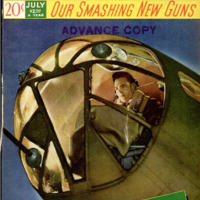 Popular Science Monthly, v. 141, n. 1, 1942
Popular Science Monthly, v. 141, n. 1, 1942


